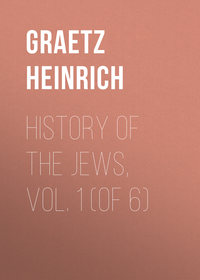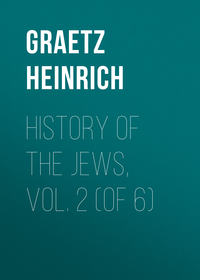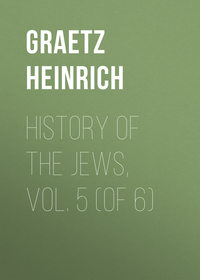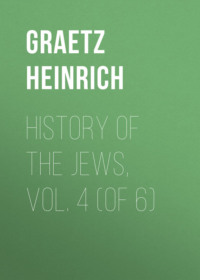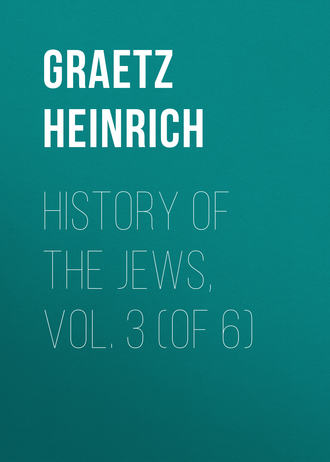
History of the Jews, Vol. 3 (of 6)
As soon, however, as it was desired to recover what had been lost for centuries, and to return with ardor to the study of Biblical literature, a need manifested itself which first had to be supplied. In supplying the Biblical text with the vowel signs invented in Babylonia or in Tiberias, it was necessary to proceed in such passages, as had not become familiar by frequent reading in public, according to grammatical rules. The Punctuators were obliged to be guided partly by tradition and partly by their sense of language. In this manner there arose the rudiments of two branches of knowledge: one treating of the above-mentioned rules of the Hebrew language, the other of the science of orthography, together with the exceptions as handed down by tradition (Massora). This apparently unimportant invention of adding certain strokes and points to the consonants thus led to the comprehension of the Holy Scriptures by the general public and the initiation of a more general knowledge of Judaism. By its help the holy language could now celebrate its revival; it was no longer a dead language employed only by scholars, but might become a means of educating the people. The auxiliary signs tended to break down the barrier between the learned (Chacham) and the unlearned (Am-ha-Arez).
An immediate consequence of contact with the Arabs and the study of the Holy Writ was the birth of neo-Hebraic poetry. Poetical natures naturally felt themselves impelled to make use of the copious Hebrew vocabulary in metrical compositions and polished verse, in the same manner as the Arabs had done with their language. But while the Arabic bards sang of the sword, of chivalry, of unbridled love, bewailed the loss of worldly possessions, and attacked with their satire such of their enemies as they could not reach with the sword, the newly-awakened Hebrew poetry knew of but one subject worthy of enthusiasm and adoration, God and His providence, of but one subject worthy of lament, the destitution and sorrows of the Jewish nation. The new-born Hebrew poetry, however different in form and matter from that of the Bible, had a religious foundation in common with it. The psalm of praise and the soul-afflicting dirge of lamentation were taken by the neo-Hebraic poets as their models. But a third element also claimed attention. Since the state had lost its independence, learning had become the soul of Judaism; religious deeds, if not accompanied by knowledge of the Law, were accounted of no worth. The main feature of the Sabbath and festival services was the reading of portions of the Law and the Prophets, the interpretation thereof by the Targumists and the explanation of the text by the Agadists (preachers of homilies). Neo-Hebraic poetry, if it was to reach the hearts of the people, could not be entirely devoid of a didactic element. The poet's only scene of action was the synagogue, his only audience, the congregation assembled for prayer and instruction, and his poetry, therefore, necessarily assumed a synagogical or liturgical character.
The poetical impulse was strengthened by practical necessity. The original divine service with its short and simple prayers was no longer sufficient. It was extended, it is true, by the recitation of psalms and appropriate liturgical compositions, but even this did not fill up the time which the congregation would gladly have spent in the house of God. This was especially felt on the New Year's festival and on the Day of Atonement, which were dedicated to deep devotion, and during the greater part of which the congregation remained in the house of prayer, contrite, and imploring forgiveness and redemption. It was evident that the divine service must be amplified, and more matter for meditation provided. In this manner arose the synagogical, or, as it was also called, the poetanic composition. At the head of the succession of neo-Hebraic poets stands José bar José Hayathom (or Haithom), whose works are not without true poetic ring, although devoid of artistic form. The date and nationality of this poet are entirely unknown, but it appears probable that he was a native of Palestine, and that he lived not earlier than the first Gaonic century.
José b. José took as the subject of his poems the emotions and memories which move a Jewish congregation on New Year's Day. On this occasion, the birthday of a new division of time, on which, according to Jewish ideas, the fate that the year has in store for men and communities is decided, God is extolled in a sublime poem as the mighty Master, the Creator of the world, the just Judge and the Redeemer of Israel. This poem, which was attached to the old prayers for the prescribed blowing of the cornet, and was intended to interpret them, embraces in a small compass the story of Israel's glorious past, its oppressed present, and promised future. José's poem is at once a psalm of triumph and of lamentation, interwoven with penitential prayers and words of hope. The resurrection is described in a few striking, picturesque lines.
Another and longer of José's poems has for its theme the ancient worship in the Temple on the Day of Atonement, which an attentive nation had once followed in devotional mood, and the description of which was well calculated to awaken the great memories of the glorious times of national independence (Abodah). It is a sort of liturgical epic, which describes simply, and without any lyrical strain, the creation of the universe and of man, the ungodliness of the first generation, Abraham's recognition of God, the election of his posterity as God's peculiar people, and the calling of Aaron's family to the service of the Temple. Arrived at the priesthood of Aaron, the poet, following the account of the Mishna, goes on to describe the duties of the high-priest in the Temple on the Day of Atonement, and concludes with the moment when the high-priest, accompanied by the whole nation, joyful and assured by visible signs of forgiveness, leaves the Temple for his home, – a beautiful fragment of the past, which has always awakened a powerful echo in the hearts of the Jewish people.
Elevation of thought and beauty of language are the characteristics of José b. José's poetry. His New Year's sonnets and Temple epic have become parts of the divine service of certain congregations, and have served as models for others. His verses are unrhymed and without meter, a proof of their great antiquity. The only artificial feature of his poetical works is the alphabetical or acrostic commencement of verses, for which several of the Psalms, Jeremiah's Lamentations, and the post-talmudical prayers served as models. In the first fruits of the new Hebraic poetry, form is completely subservient to the subject-matter. There has been preserved from ancient times another Abodah, ascribed to a poet named Simon ben Caipha. It appears to have been written in imitation of that of José b. José, but is greatly inferior to its model. However, it was honored by being adopted by the synagogue of the Gaonate. To the name of Simon Caipha, which sounds like the Jewish name of the apostle Peter, a peculiar legend is attached: The apostle, who supports the foundation of the Catholic Church, is represented as having written this Abodah in order to declare in the opening part his truly Jewish acknowledgment of God's unity, and to renounce his adherence to Jesus, as though the disciple who three times denied his Master had desired in this liturgical poem to attest his unbelief.
It was impossible that Jewish liturgical poetry could long remain satisfied with this simplicity of form. Little by little the Jews became acquainted with the poetry of the Arabs, the agreeable sound of its rhymes captivated them, and they were led to regard rhyme as the perfection of poetry. The poetanists, therefore, if they would be well received, could not afford to neglect this artistic device, and they assiduously devoted themselves to its cultivation. As far as is known, the first poet who introduced rhyme into the neo-Hebraic poetry was a certain Jannai, probably an inhabitant of Palestine. He composed versified prayers for those special Sabbaths which, either by reason of historical events connected with them, or of being a time of preparation for the approaching festivals, were possessed of particular importance. The Agadic discourses, which had been introduced on these Sabbaths, do not seem to have pleased the congregations any longer, because the preachers were unable to find new and attractive matter; they seem, indeed, to have read out the same discourses in a given order from year to year.
The poems of Jannai and his fellow-workers aimed at giving the substance of these Agadic expositions in the form of agreeable verse. Hence, Jannai's productions are versified Agadas. But as he was not enough of a poet to reproduce the elevated and striking passages of Agadic literature, as his rhymes were heavy and labored, and as he also burdened himself with the task of commencing his verses with consecutive letters of the alphabet, and of interweaving his name into them, his poems are dull, clumsy, and unwieldy.
Altogether neo-Hebraic poetry gained nothing during its earlier years by the introduction of rhyme. Eleazar ben Kalir or Kaliri (of Kiriat-Sepher), one of the first and most prolific of the poetanic writers, and a disciple of Jannai, was just as clumsy and harsh as his master, and his style was even more obscure. He wrote over 150 liturgical pieces, including hymns for the festivals, penitential prayers for the holy-days, songs of lamentation for the principal fasts, and various other compositions which cannot be classed under distinct heads. Kaliri put into most artificial verses a large portion of the Agadic literature, but only a few of his compositions have any poetical value, and none possesses beauty. In order to overcome the difficulties which were presented by the allusions to the Agada, by the use of rhyme, of the alphabetically arranged initial words and the interweaving of his name, Kaliri was obliged to do violence to the Hebrew language, to set at defiance the fixed rules which govern the use of words, and to create unprecedented combinations. In place of word-pictures, he often presents to his reader obscure riddles, which it is impossible to solve without a thorough acquaintance with the Agadic writings. Nevertheless, Kaliri's poetic compositions made their way into the liturgies of the Babylonian, Italian, German, and French Jews; the Spaniards alone, guided by delicate feeling for language, refused to adopt them. Kaliri was honored as the greatest of the poetanic writers, and tradition has glorified his name.
By the introduction of these compositions, the liturgy acquired an altered character. The translation of the portions of the Law which were read out to the congregation, and the Agadic expositions thereof, which, as the Jews of the Islamic empire adopted the Arabic language, had become unfamiliar to the multitude, gradually disappeared from the divine service, and their places were filled by metrical compositions (Piyutim) which answered the same purpose, and at the same time possessed the advantage of a poetical character. By this means considerable extension was given to the divine service. The reader supplanted the preacher. Singing was introduced into the synagogue, as the poetical prayers were not recited, but chanted (Chazanuth). Special tunes were introduced for the various prayers. But the poetanic compositions were not adopted by all congregations as part of their divine service. The Talmudical authorities were at first opposed to their adoption, for the reason that they were usually interpolated between the various divisions of the principal prayer, and in this manner destroyed the continuity and coherence of its separate parts.
The return to the source of the Bible had the result of kindling a poetic flame in artistic natures; but, at the same time, it fanned into existence a wild spirit which at first brought trouble, schism, and malediction in its train, although afterwards it became a source of purification, vigor, and blessing to the Jews. The origin of this movement, which divided the Jewish commonwealth of the east and west into two camps, dates from the first Gaonic century.
The Babylonian Talmud held sway over the Jewish community in Babylonia; it was not only a code, but also the constitution for the community of which the Prince of the Captivity and the two presidents of the Talmudical colleges were the chief dignitaries. By the expansion of the Islamic dominion from India to Spain, from the Caucasus far down into Africa, the authority of the Talmud was extended far beyond its original bounds; for the most distant congregations placed themselves into communication with the Geonim, submitted points of religion, morals, and civil law to them for advice, and accepted in full faith their decisions, which were based on the Talmud. The Babylonian-Persian communities felt themselves in nowise hampered by the Talmudical ordinances, which were of their own creation, and had sprung up in their midst, the outcome of their views, morals, and customs, the work of their authorities. The African and European communities were too unlearned in the Bible and the Talmud to be able to express an opinion on the matter. They accepted the decisions of the Geonim as law, without greatly troubling themselves as to their agreement with the Bible.
Not so, however, with the Arabian Jews who had emigrated from Arabia to Palestine, Syria and Irak, the Benu-Kainukaa, the Benu-Nadhir, and the Chaibarites. They were sons of the desert, men of the sword, soldiers and warriors, accustomed from their childhood to a free life and to the development of their strength; men who cultivated social intercourse with their former Arabic allies and fellow-soldiers, in whose midst they again settled after the conquest of Persia and Syria. Judaism was indeed dear to them, for they had sacrificed liberty, country, fame and wealth in its cause, and had resisted Mahomet's importunities, and had not allowed themselves to be converted to Islam. But between the Judaism which they practised in Arabia, and the Judaism taught by the Talmud, and set up as a standard by the colleges, there lay a deep gulf. To conform to Talmudical precepts, it would have been necessary for them to renounce their genial familiarity with their former comrades, and to give up their drinking-bouts with the Arabs which, despite their interdiction by the Koran, the latter greatly loved. In a word, they felt themselves hampered by the Talmud.
The Jews of Arabia, who came into close contact with the Mahometans, and were, therefore, frequently involved in controversy as to whether Judaism was still possessed of authority or had been superseded by Islam, were obliged, so as not to be at a loss in such discussions, to familiarize themselves with the Bible. They in that way probably discovered that much of what the Talmud and the colleges declared to be religious precept, was not confirmed by the Bible. But from whatever cause this aversion to Talmudical precepts may have arisen, it is certain that it first had its origin in the Arabian Jewish colony in Syria or Irak. It is related, in an authentic source, that during the first part of the eighth century, many Jews allowed themselves to be persuaded to abandon Talmudical Judaism and to conform only to the precepts of the Bible.
The leader of this movement was a Syrian, Serene (Serenus) by name, who called himself the Messiah (about 720). He promised the Jews to put them into possession of the Holy Land, having first, of course, expelled the Mahometans. This attempt to regain their long-lost independence was perhaps occasioned by the fanatical Caliph Omar II (717–720). That bigoted prince, who had been raised to the throne by the intrigues of a zealous reader of the Koran, had re-enacted the restrictive laws of his predecessor, Omar I (the covenant of Omar), which had fallen into oblivion under the politic Ommiyyades. After his accession to the throne, he wrote to his governors as follows: "Do not pull down a church or a synagogue, but do not allow new ones to be built within your provinces." Omar devoted himself to making proselytes, holding out attractive promises to the new converts, or unceremoniously compelling both Jews and Christians to embrace Islam. It was probably for this reason that the Jews were disposed to support the false Messiah, and to lend credence to his representations that he would make them free again in the land of their fathers, and exterminate their enemies. Upon his banner Serene inscribed the release from Talmudical ordinances; he abolished the second day's celebration of the festivals, the prescribed forms of prayer, and the laws of the Talmud relating to food: he permitted the use of wine obtained from non-Jews, and sanctioned marriage between persons of nearer relationship than was allowed by the Talmud, as also celebration of marriages without a marriage-contract. It is probable that this hostility towards the Talmud gained him many adherents.
Serene's fame spread as far as Spain, and the Jews of that country resolved to abandon their property and to place themselves under the leadership of the pseudo-Messiah. Hardly ten years after the Jews of Spain had been delivered from the yoke of the Visigoths by the conquests of the Mahometans, they, or at least many of them, were desirous of again abandoning their newly-acquired fatherland. It appears that they were dissatisfied with the rule and administration of the Mahometan governors. As they had rendered signal services to the Arabs in the conquest of the Peninsula, they probably expected particular consideration and distinction, and instead of this they were impoverished equally with the Christians. Serene's fate was miserable, as indeed he deserved. He was captured and brought before the Caliph Yezid, Omar II's successor, who put an end to his Messianic pretensions by propounding insidious questions to him, which he was unable to answer. Serene is said, however, to have denied before the Caliph that he had had any serious designs, but that he only intended to make game of the Jews; whereupon the Caliph handed him over to the Jews for punishment. Many of his adherents, repenting of their easy credulity, desired to rejoin the communities from which they had severed themselves by infringement of the Talmudical ordinances. The Syrian communities were doubtful, however, whether they ought to re-admit their repentant brethren into their midst, or whether they ought not to be treated as proselytes. They referred the matter, therefore, to Natronaï ben Nehemiah, surnamed Mar-Yanka, the principal of the college at Pumbeditha, and successor of Mar-Raba (719–730). Natronaï's decision concerning the reception of Serene's adherents was conceived in a liberal spirit, and ran as follows: According to the laws of the Talmud, there is nothing to prevent them from being re-admitted by the communities and being treated as Jews; but they are to declare openly in the synagogues their sorrow and repentance, and to promise that their future conduct shall be pious and in accordance with the precepts of the Talmud, and in addition they are to suffer the punishment of flogging. At that time there were also other apostates, who went so far as to disregard the Biblical precepts concerning the Sabbath, the ritual for slaughtering cattle, the eating of blood, and the intermarrying of near relations. It is not known, however, in what country these people lived. Without declaring either for Christianity or Islam, they had entirely severed their connection with Judaism. When some of these sought re-admission into the fold of Judaism, Natronaï was again asked for his opinion. He said, "It is better to take them under the wings of God than to cast them out."
At about this time the Jews of the Byzantine empire were subjected to severe persecution, from the effects of which they did not for a long time recover, and this, too, at the hands of a monarch from whom they had least expected hostile treatment. Leo, the Isaurian, the son of rude peasant parents, having had his attention drawn by the Jews and the Arabs to the idolatrous character of the image-worship which obtained in the churches, had undertaken a campaign with the intention of destroying these images. Being denounced, however, before the uncultivated mob as a heretic and a Jew by the image-worshiping clergy, Leo proceeded to vindicate his orthodoxy by persecuting the heretics and the Jews. He issued a decree commanding all the Jews of the Byzantine empire and the remnant of the Montanists in Asia Minor to embrace the Christianity of the Greek Church, under pain of severe punishment (723). Many Jews submitted to this decree, and reluctantly received baptism; they were thus less steadfast than the Montanists, who, in order to remain faithful to their convictions, assembled in their house of prayer, set fire to it, and perished in the flames. Such of the Jews as had allowed themselves to be baptized were of the opinion that the storm would soon blow over, and that they would be permitted to return to Judaism. It was, therefore, only outwardly that they embraced Christianity; for they observed the Jewish rites in secret, thereby subjecting themselves to fresh persecutions. Thus the Jews of the Byzantine empire pined away under unceasing petty persecution, and for a time they are hidden from the view of history.
Many Jews of the Byzantine empire, however, escaped compulsory baptism by emigration. They quitted a country in which their forefathers had settled long before the rise of that Church which had so persistently persecuted them. The Jews of Asia Minor chose as their home the neighboring Cimmerian or Tauric peninsula (the Crimea), whose uncivilized inhabitants, of Scythian, Finnish and Sclavonian origin, practised idolatry. These Alani, Bulgarians and Chazars were, however, not jealous of men of other race and of a different belief who settled in their vicinity. Thus, side by side with the Jewish communities which had existed from early times, there arose new communities on the shores of the Black Sea and the Straits of Theodosia (Kaffa), and in the interior, in Sulchat (Solgat, now Eski-Crimea), in Phanagoria (now Taman), and on the Bosporus (Kertch), which lies opposite. From the Crimea the Greek Jews spread towards the Caucasus, and the hospitable countries of the Chazars on the west coast of the Caspian Sea and at the mouth of the Volga (Atel). Jewish communities settled in Berdaa (Derbend), at the Albanian Gates, in Semender (Tarki), and finally in Balanyiar, the capital of the land of the Chazars. By their energy, ability and intelligence, the Greek-Jewish emigrants speedily acquired power in the midst of these barbarian nations, and prepared the way for an important historical event.
Hardly thirty years after the fall of the false Messiah, Serene, an anti-Talmudical movement, coupled with Messianic enthusiasm, was again set on foot, but this time on a different scene. The prime mover was a fantastic and warlike inhabitant of the Persian town of Ispahan, one Obaiah Abu-Isa ben Ishak. He was not an ignorant man; he understood the Bible and the Talmud, and was capable of expressing his thoughts in writing. It is said that he was made aware of his call to an exalted vocation by a sudden cure from leprosy. Abu-Isa did not proclaim himself to be the Messiah, but asserted that he was the forerunner and awakener (Dâï) who was to prepare for the coming of the Messiah. His views concerning the office of precursor of the Messiah were, indeed, altogether peculiar. He taught that five forerunners would precede the Messiah, and that each one would be more perfect than his predecessor. He considered himself the last and most perfect of the five, and of equal merit with the Messiah. He assumed his vocation in good earnest, and announced that God had called him to free the Jewish race from the yoke of the nations and of unjust rulers.
The Messianic precursor of Ispahan found many partisans, 10,000 Jews, it is said, gathering around him for the purpose of aiding him in his work of deliverance. To them Abu-Isa expounded a form of Judaism differing in some respects from that accepted at the time; the points of difference, however, are not known. He entirely abolished divorce, even in the case of adultery. He augmented the three daily periods for prayer by four new periods, citing in support of this innovation the verse of a psalm: "Seven times a day do I praise thee." Abu-Isa retained the forms of prayer as prescribed by the Talmud, and in no way disturbed the existing order of the calendar. He explained his own peculiar system of religion in one of his works, in which he prohibits the use of meat and wine by his followers, but pronounces the abrogation of sacrificial worship.


